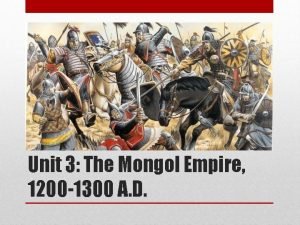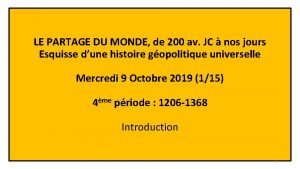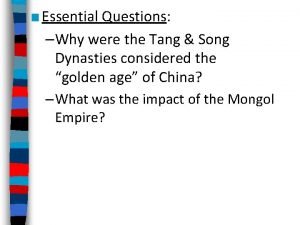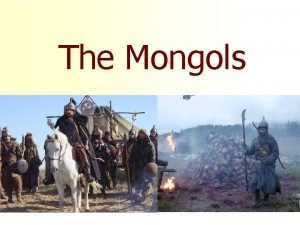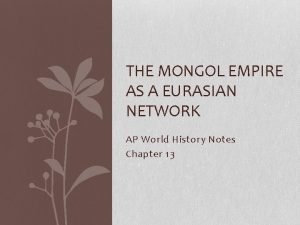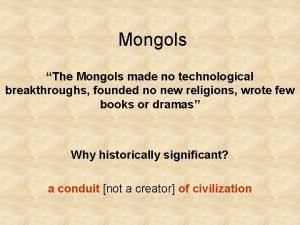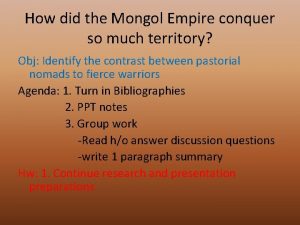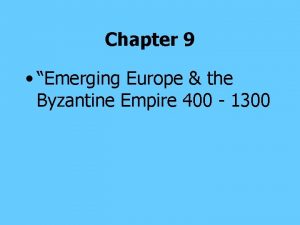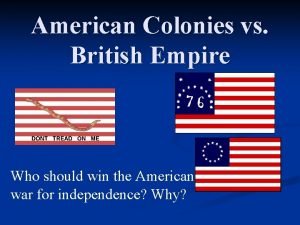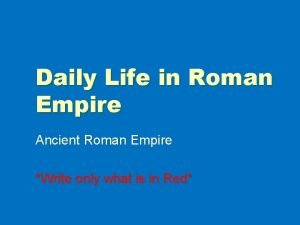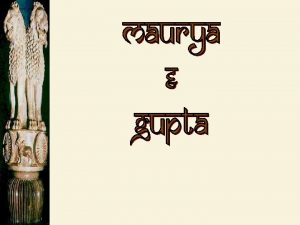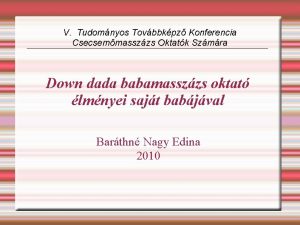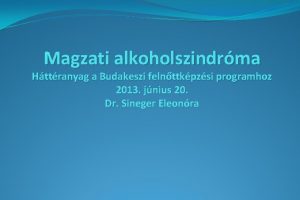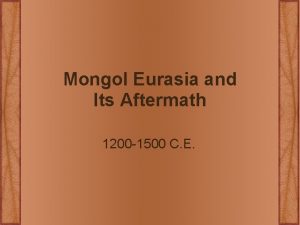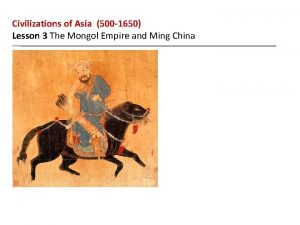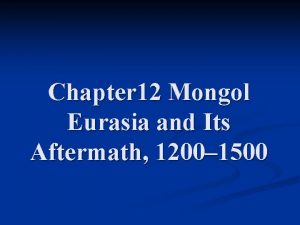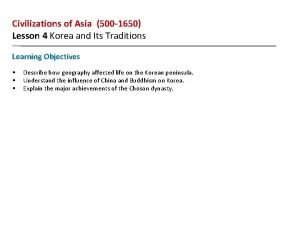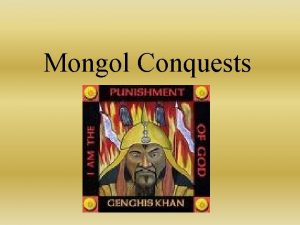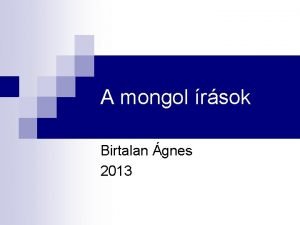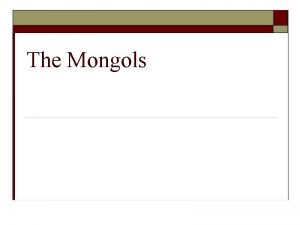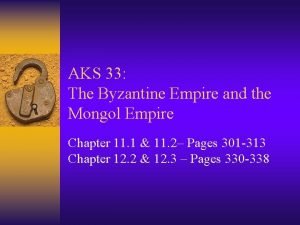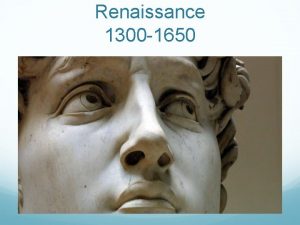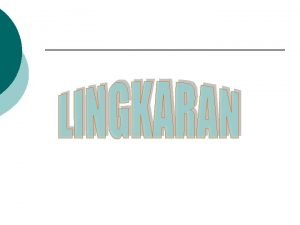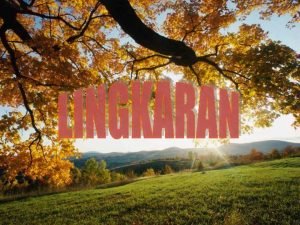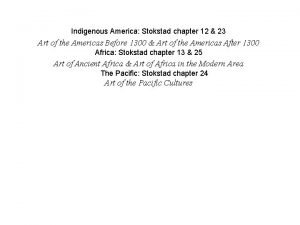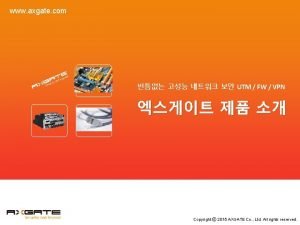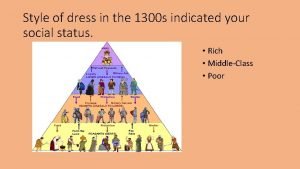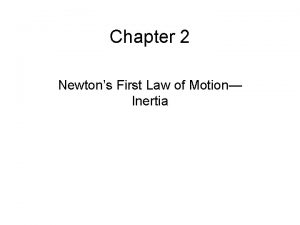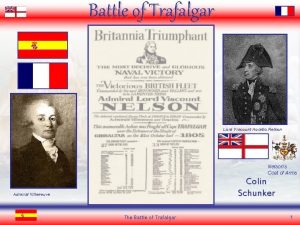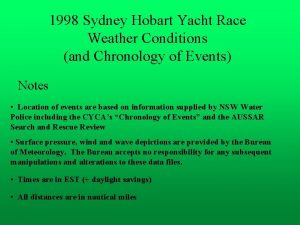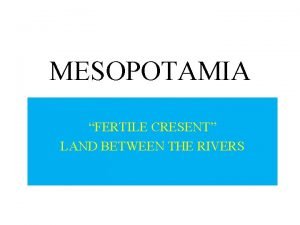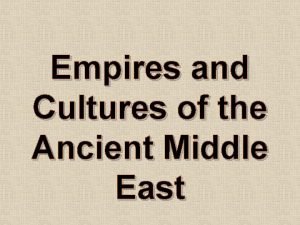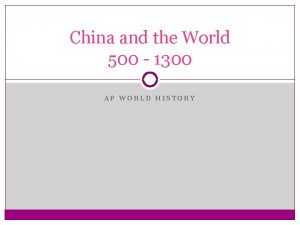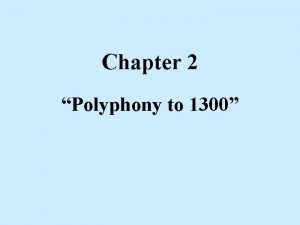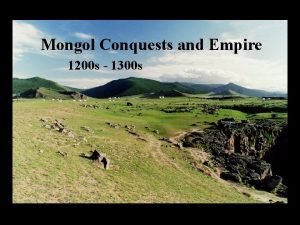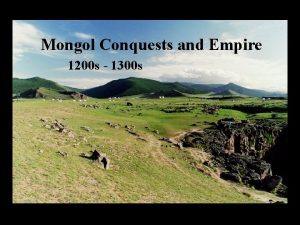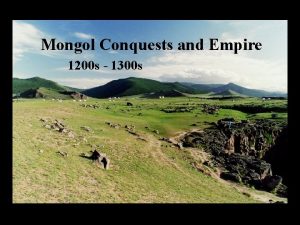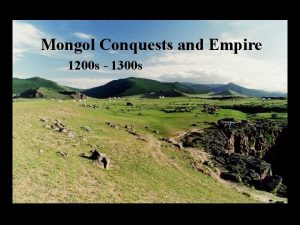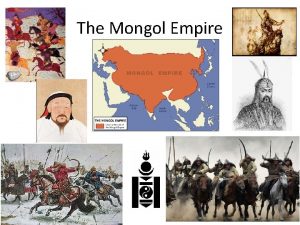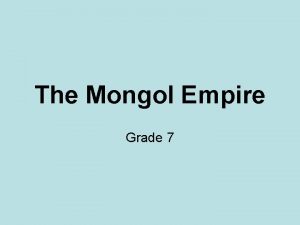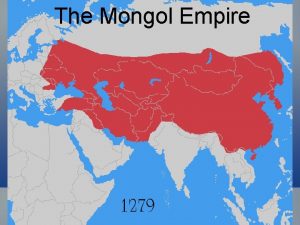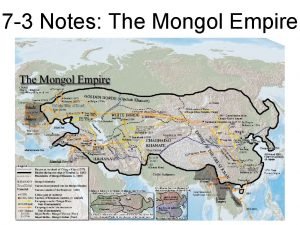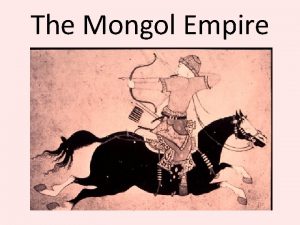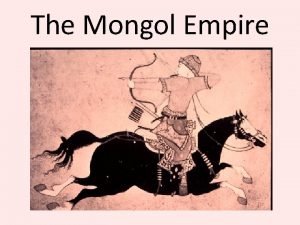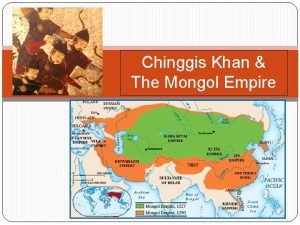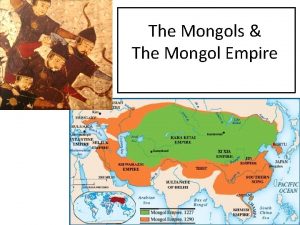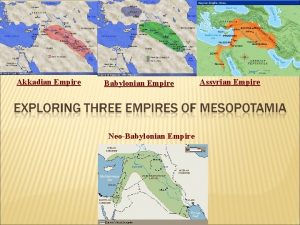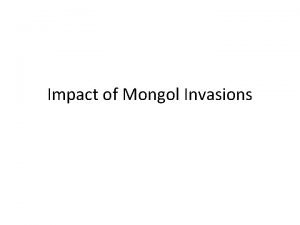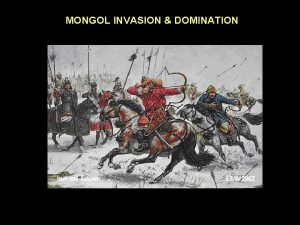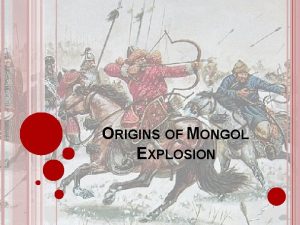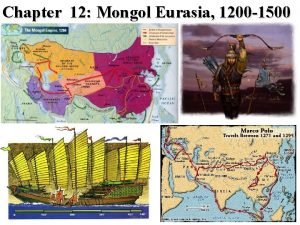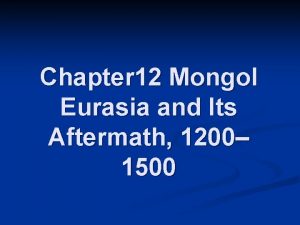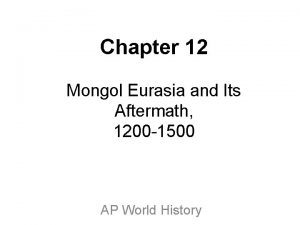Unit 3 The Mongol Empire 1200 1300 A





































- Slides: 37

Unit 3: The Mongol Empire, 1200 -1300 A. D.

Who said it?

“The Mongols made no technological breakthroughs, founded no new religions, wrote few books or dramas” Why historically significant?

Who Were the Mongols? • Herdsman from the grassy plains above the Gobi Desert • Culture is defined by the horse- Lifestyle- nomadic - Jobs- Herdsman and trade - Skills- Horse riding, combat, trade - Military (Calvary) - Weapons (Light and mobile)- swords, bows, and spikes - Education- Mostly illiterate - Government- groups were small- controlled by a Khan, or Chief, no written laws. - Leader- Person become a “Khan” by displaying their skills in combat

Time Line Dates: • • • 1206 -1227 1211 -1234 1219 -1221 1229 - • • • 12601274127912811294 - 1237 -1241 1240124112511259 - Reign of Chinggis Khan Conquest of northern China Conquest of Persia Ogedei Khan Takes Power Ogedei Khan Sends soldiers to Korea- Conflict occurs for decades Conquest of Russia Mongols enter the Ukraine city of Kiev Mongols fight Hungary and Poland at the Battle of Lenica, in Poland Ogedei Khan dies Mongke Khan takes power Mongols conquer Baghdad, then Damascus, Syria- Mongke Khan dies in combat Kublai Kahn assumes power over Mongol Empire Failed Mongol Invasion of Japan Conquest of Southern China, Kublai creates Yuan Dynasty Second Failed Mongol invasion of Japan Kublai Kahn Dies

Genghis Khan Life: • Born 1164 A. D. as Temujin, Died 1227 • Mother was sold into slavery • Adopted son of a a powerful chief • United warring clans of Mongolia • Gave himself the title “Genghis Khan, ” or Universal Leader • Great Skills in Managing Reforms: Conquests: • Yassa- or Code of Laws • Outlawed- Kidnapping of Women - Forced Marriages - Stealing - Disobedience to the khan • Introduced Record Keeping • Modern Police Force • Tax Collecting • • • Peace with Uyghur tribes Conquered Northern China Eastern Persia Eastern Europe Greatest Conqueror of all time

The Mongol Empire • • Ogedei Khan Dominated Russia into the 1400 s Reached as far west as Central Europe, Poland Hungary Retreated in response to Ogedei Khan’s death in 1241 Under the Khans, people were allowed to worship as they chose, and Buddhism, Islam and Christianity flourished Introduced Mail-System, Tax-System, Executed officials for corruption 1258 - Conquered Baghdad, Modern-day Iraq 1259 - Conquered Damascus, Modern-day Syria Welcomed by Christians and Shi’a Muslims in Middle. East region Monke Khan


Kublai Kahn • United China in 1279 • Called it a Chinese name, The Yuan Dynasty • Cultural Diffusion- took on many Chinese customs • Became powerful through control of Silk Road • Developed a large Navywith conquest of Korea and Northern China

Kublai Kahn • He once said “One can conquer the world on horseback, but one cannot rule the world on horseback. ” What did he mean?

Kublai Khan (Cont. ) • Interfered with Chinese economy, supported the merchant class, with much anger from Confucianist Chinese • Became weak because Conservative Mongols believed he betrayed the old nomadic way • Alienated local Chinese population because he saved the most powerful jobs in government for native Mongols.

• Success • Defeated Song in 1279 and united China Defeats • Naval Conflict 1274 -Japan • Naval Conflict 1281 -Japan • Java, 1292 Successes and Defeats


Kamikaze- 1281


The Mongol Art of War • Great horsemen and archers • Large, quickly moving armies • “cutting edge weapons” • Masters at psychological warfare: “By putting cities to the sword, they let terror run ahead of them” John Fairbank A “ger”


• The Mongols were skilled horsemen and mounted archers. Their bows were the best of the time. The main weapons were the, axe, and bow. • Heavier cavalry also used lances.

• One type of battle formation was consisted of five squadrons spread wide apart • The two spearhead ranks wore the heaviest armor as well as the heaviest weaponry. When an attack began, the three rear ranks broke through the openings between the lines of the front ranks, and harassed the opposing army with continuous hails of arrows. When this had worked its effects for some time, the rear ranks would withdraw in order to be able to encircle the opponent's forces in the event of an attempt of escape. Simultaneously, the front ranks would charge and deliver a decisive blow, and now they would finally engage in close combat • Encirclement strategies, often on a very large scale, the Mongols would prioritize mobility and swiftness • They simply wanted to harass the opponent with feints, showers of arrows and javelins until the opposing army was "ripe. " When the opposing forces were outflanked, sufficiently angered, exhausted and disorganized, the charge began. Battle Formations

Strong Equestrians and Archers • The Mongols were oriented around extreme mobility. They carried their houses with them, drank their own horse's blood to stay alive, and could travel up to 62 miles per day. • They had an elaborate priority-mailsystem which allowed orders to be transmitted rapidly across Eurasia. • Mongol archers were very deadly and accurate • Their arrows could kill enemies at 200 meters (656 feet)

• The warrior carried a protective shield made of light leather armor • which was impregnated with a lacquer-like substance in order to make it more impervious to penetration by arrows, swords and knives, and also to protect it against humid weather • The Mongol warrior used to wear Chinese silk underwear, if it could be obtained, because it was a very tough substance • • If arrows are shot from a long distance, it would not penetrate the silk It would also prevent poison from entering the bloodstream • • • During winter they wore several layers of wool as well as heavy leather boots with felt socks on their feet. The legs were often protected by overlapping iron plates resembling fish scales, which were sewn into the boots. Each warrior carried a battle axe, a curved sword known as scimitar; a lance, and two versions of their most famous weapon: the Mongol re-curved bow. • One of the bows was light and could be fired rapidly from horseback, the other one was heavier and designed for longrange use from a ground position Mongol War Equipment

• Genghis Khan used combined fake retreats with accurate Manguadai Horse Archers to pick off his European enemies. • Genghis Khan slaughtered a few cities, in an attempt to scare all other cities to surrender without a fight. He, being a practical leader, also valued smarts more than bravery • If enemies surrendered without resistance, the Mongols usually spared their lives, and they provided generous treatment for artisans, craft workers, and those with military skills • In the event of resistance, the Mongols ruthlessly slaughtered whole populations, sparing only a few, whom they sometimes drove their armies as human shields during future conflicts Psychological Warfare

The Mongols were “terrible to look at and indescribable, with large heads like buffaloes’, narrow eyes like a fledgling’s, a snub nose like a cat’s, projecting snouts like a dog’s, narrow loins like an ant’s, short legs like a hog’s, and by nature with no beards at all…” An Armenian observer Another description:



Also The Mongols made an impact by. . . • adapting the use of gunpowder, improving it, and spreading its use. • spreading the Bubonic Plague (the Black Death) • Creating a situation in which new groups could take control of territories after the Mongols retreated (Ottoman Turks)

The Travels of Marco Polo • B. 1254 - D. 1324 • Venetian merchant who journeyed across Asia along the “Silk Road” during the rule of Kublai Khan • Arrived in the Mongol Capital of “Xanadu” in 1275 • Served as diplomat and tax collector for Kublai Khan • Spoke of China’s Technology (eye-glasses, paper money, and use of coal), great wealth, modern and prosperous cities. • Returned in 1295 - inspiring new generation of travelers and merchants (Christopher Columbus) History. com http: //www. history. com/topics/exploration/marco-polo Biography http: //www. biography. com/people/marco-polo-9443861/videos/marco-polo-anamazing-tale-2080070187

• Mongols are “Nomadic” • Brave and obedient soldiers • “Cruel by Nature” • Society’s goals and resources directed towards war Marco Polo’s Description of the Mongols- 1271 -1295 A. D.

Europe Mongol Empire



Marco Polo- Twitter Assignment http: //afe. easia. columbia. edu/mongols/pop/men u/class_marco. htm#travels • Using your Marco Polo Documents, create a make-believe twitter account for Marco-Polo • What would Marco Polo Tweet? - Opinions - Observations • Rubric. Color _____/20 pts Formatting _____/20 pts Interpretation _____/20 pts Spelling _____/20 pts Creativity _____/20 pts

• • One tweet about before he left for Asia Two Tweets from Document one Two Tweets from Cambulac Document Two Tweets about the Mail System Two Tweets Hangchow Two Tweets about Soochow One Tweet about his return. Project must have 12 tweets total Project Guidelines

Mongol trade and the Silk Road A. Genghis Khan realized potential wealth of control B. Attacked Turkish, Arabian, and Persian tribes for control of the silk road C. Brought under complete control with Kublai Khan’s control of China D. Mongolian domination stimulated caravan trade between China and the European and Middle Eastern countries E. Silk, Gold, Jewels, Ivory, Gun powder, Religion, and diseases were brought to Europe along the Silk Road

Result of Trade: The Black Death • Open trade on the Central Asian routes, which diseases passed from one region to another with ease. • In the 1340 s, merchants helped spread the terrifying Black Death throughout Europe. • 35 -60% of Europe killed between 1346 -1353 • Between 75 and 200 million dead- worldwide • Contributed to the decline of Mongol Power in Central Europe and China


 Cambulac mongolia
Cambulac mongolia 1200-1300 lexile books
1200-1300 lexile books Empire mongol apogée
Empire mongol apogée How big did the mongol empire get
How big did the mongol empire get The mongol empire spans eurasia answer key
The mongol empire spans eurasia answer key The mongol empire as a eurasian network
The mongol empire as a eurasian network Mongol empire memes
Mongol empire memes The mongol empire spans eurasia answer key
The mongol empire spans eurasia answer key The byzantine empire and emerging europe
The byzantine empire and emerging europe American empire vs british empire
American empire vs british empire Rich and poor romans
Rich and poor romans Mauryan empire and gupta empire venn diagram
Mauryan empire and gupta empire venn diagram Mongol redő
Mongol redő Mongol redő
Mongol redő Mongol redő
Mongol redő Are vikings turkic
Are vikings turkic Mongol hierarchy
Mongol hierarchy How did kublai khan organize mongol rule in china
How did kublai khan organize mongol rule in china Mongol hierarchy
Mongol hierarchy How did kublai khan organize mongol rule in china
How did kublai khan organize mongol rule in china Asian massage mongol
Asian massage mongol Mongol írás
Mongol írás What was the impact of russia’s “mongol years”?
What was the impact of russia’s “mongol years”? What was the impact of russia’s “mongol years”?
What was the impact of russia’s “mongol years”? 1650-1300
1650-1300 Pada gambar disamping abcd adalah segi empat tali busur
Pada gambar disamping abcd adalah segi empat tali busur Jumlah sudut segi lima
Jumlah sudut segi lima Art of the americas before 1300
Art of the americas before 1300 Axgate 7000
Axgate 7000 Reading inventory lexile chart
Reading inventory lexile chart 1300 dress
1300 dress When burl and paul stand on the scaffold
When burl and paul stand on the scaffold 1300 hrs
1300 hrs 1300 hrs
1300 hrs What does fertile cresent mean
What does fertile cresent mean Solomon's temple location
Solomon's temple location Hangzhou definition ap world history
Hangzhou definition ap world history Notre dame organum
Notre dame organum
